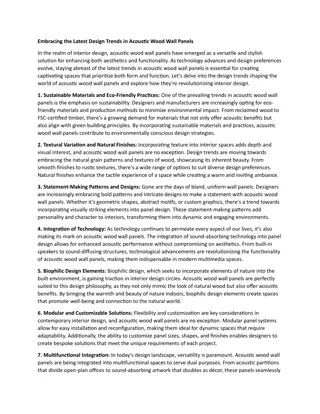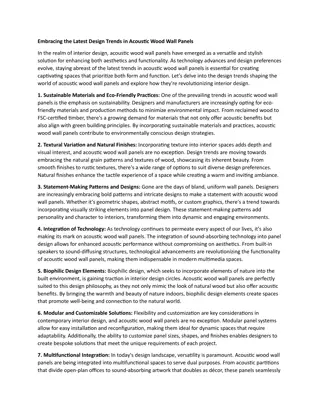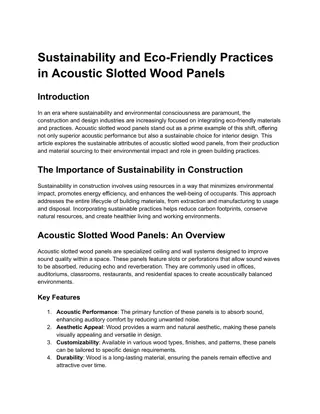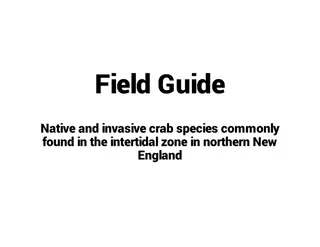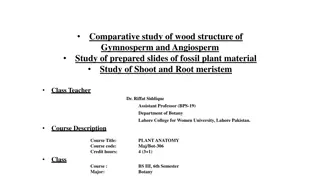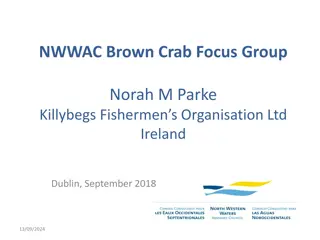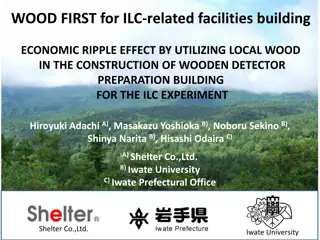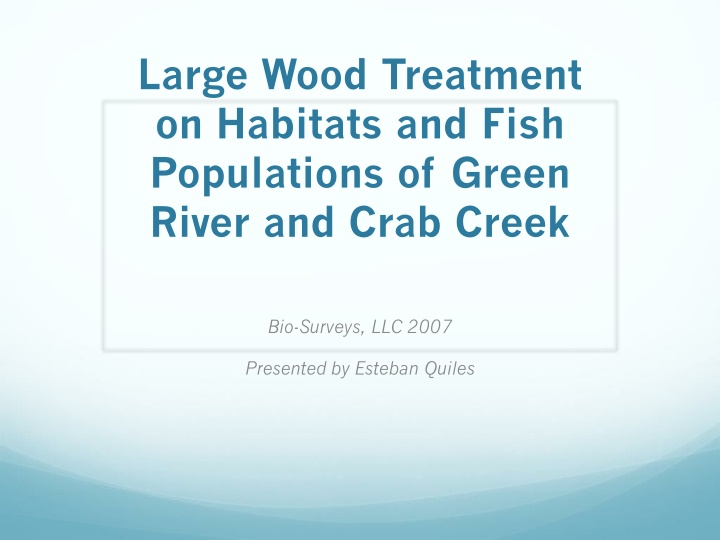
Wood Treatment Effects on Green River and Crab Creek Habitats
Explore the impact of large wood treatment on habitats and fish populations in Green River and Crab Creek. Detailed analysis of project details, results, general trends, and recommendations are presented based on the unified table results. Changes observed in pool depth, pool surface area, spawning gravel, and habitat formation are highlighted. Specific outcomes for Crab Creek, including habitat area, pocket watering, wood counts, as well as adjustments such as changes in scour pools and beaver pond abundance, are discussed.
Download Presentation

Please find below an Image/Link to download the presentation.
The content on the website is provided AS IS for your information and personal use only. It may not be sold, licensed, or shared on other websites without obtaining consent from the author. If you encounter any issues during the download, it is possible that the publisher has removed the file from their server.
You are allowed to download the files provided on this website for personal or commercial use, subject to the condition that they are used lawfully. All files are the property of their respective owners.
The content on the website is provided AS IS for your information and personal use only. It may not be sold, licensed, or shared on other websites without obtaining consent from the author.
E N D
Presentation Transcript
Large Wood Treatment on Habitats and Fish Populations of Green River and Crab Creek Bio-Surveys, LLC 2007 Presented by Esteban Quiles
Overview Project details Results Crab Creek Results Green River Unified table results General trends Recommendations Conclusion
Project details Places under study: Crab Creek and Green River (Washington State). This report describes the effects treatment on channel structure and Coho populations of the treated sections of these streams. Trees averaged about 120 feet long and ranged in diameter at the large end from 24 - 36" inches. Crab Creek received 172 trees. Green River 248 trees.
Project details cont. . . Primary target for this study was to quantify changes in over-winter survival rates for juvenile Coho associated with the introduction of large amounts of full spanning trees. A note about Large wood placement: Until a major high water event occurs, full- spanning wood may exist in a relatively passive state.
These were the first set of changes observed. Change Change observed Pool depth Modest to undetectable changes have occurred in residual pool depth. Pool surface area The number of pools having a residual depth > 1m increased slightly as did their surface area Spawning Gravel observed to have a 93% increase, pre-project year to the most recent post-project year. Habitat formation Channel roughness was also seen to increase, as a result.
Results Crab Creek cont. . . Second set of changes observed Change Change observed Habitat area Side channel habitat has increased post-treatment, providing almost four times the area Pocket watering Pocket watering increased from 28 in 2000 to 71 in 2006. ( increased by 43) Total area of these pocket waters increased as well. The post-project wood counts of both years exceed the sum of pre-project and treatment wood. With 173 species of Native wood recruited. Large wood Pre-project + Treatment = 742 Post-project (2006) = 915
Crab Creek results cont.. .(adjustment changes) Scour pools decreased in number from 143 to 121. Scour pool surface area also decreased. Beaver pond abundance decreased. Rearing capacity of the summer channel progressively decreased by 15,000 from 2000- 2006.
Results: Green River These were some of the changes seen in the Green River project. Change Change observed Main stream habitat mainstem primary channel habitat units increased from 158 pre- treatment to 202 post- treatment. Scour Pools number of scour pools increased from (83 to 119) Riffle habitats riffle habitats increased from (63 to 79) Winter Coho carrying capacity The winter abundance has exhibited a steady increase with no indication of a ceiling in capacity.
Results Green River: Adjustments These were some of the adjustments seen in the Green River project Change Scour pools Change observed average lengths decreased from 56m to 45m, and riffles from 28m to 18m. Scour depth may have decreased slightly overall Pool depth and specifically deep, sheltering pools of the Reach 1mainstem primary channel appear to have decreased post-treatment Pool Depth Summer Coho carrying capacity Summer carrying capacity has decreased slightly Dam Pools Seven dam pools occupying 1,972m2 were recorded in 2000. None were recorded in 2006.
General trends both projects Coho salmon populations generally saw a decrease in rearing capacity in the six year period of study. Pools and riffle habitats generally increased in number but lost complexity, and depth as a result. Channel complexity was not accomplished, during project period.
Recommendations Authors suggest a longer time period of study, up to 10 years. More intricate log placement. Wood treatment structures would be far more effective if composed of open grown trees having complex branching. Log structures produce varied and sometimes opposing effects involving trapping and deflection.
Conclusion Crab Creek restoration: Recruited spawning gravels. Recruited large native trees. Rearing capacity decreased over study period. Green River restoration: Increased habitat availability. Reduction in habitat quality.


